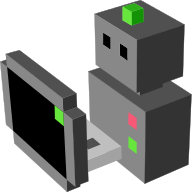Getting started: basic MORSE usage¶
Starting MORSE¶
Use the morse executable program, with the corresponding option, to start
a simulation.
To verify that your installation and configuring of MORSE is correct, execute:
$ morse check
To start the simulation right away, do:
$ morse run <filename>
Where filename can be a Blender file or a Python script that uses the
Builder API to describe a simulation scenario.
To load the simulation scene in the Blender interface:
$ morse edit <filename>
This will give you the chance to modify the scene before pressing p to start the simulation.
Additionally, the following options can be given to the MORSE executable:
- -h / –help: print an explanation of the available options and exit
- -b BASE / –base BASE: in Edit mode, specify a Blender scene used as base to apply the Python script
- –name NAME: when running in multi-node mode, sets the name of this node (defaults to current hostname)
- -c / –color: uses colors for MORSE output.
- –reverse-color: uses darker colors for MORSE output.
- -g GEOM / –geometry GEOM:
sets the simulator window geometry. Expected format:
WxHorWxH+dx,dyto set an initial x,y delta (from lower left corner). - -v / –version: returns the current MORSE version
MORSE controls¶
A simulation in MORSE is executed using Blender’s Game Engine mode. When
in this mode, Blender’s button panels are disabled and the controls
change. When running morse edit <filename>, it is recommended to switch
the Blender 3D View window to full screen before starting a simulation. Press
Ctrl-Up when the mouse is over a window to toggle it to full screen and
back.
Simulation camera control¶
The default MORSE scene, as well as most of the provided scenario files, contain an object called CameraFP. This allows the user to control the view of the scene during the simulation using the mouse and keyboard, in the same way as in a First Person Shooter game. The camera can be moved around using:
- w/z, s to move forward and backward
- a/q, d to move left and right
- r, f to move up and down
The direction the camera points in is controlled by the mouse. Hold down the Ctrl key while moving the mouse.
It is possible to adjust the speed of the camera’s movement by selecting the CameraFP object in the scene, and adjusting the camera object’s game properties: Sensitivity for the mouse, and Speed for the keyboard.
Standard keyboard functions¶
The following key bindings are predefined in any simulation scene
- p key: start the simulation (start the Game Engine)
- h key: show an on screen display with this list of keyboard functions
- v key: toggle the display of a “picture-in-picture” screen that can display the image viewed from a specified camera. The camera to display is determined from the Builder API Environment class’ select_display_camera option.
- Esc key: stop and exit the simulation (cleaning up the connections)
- F7 key: move the camera CameraFP near to the robot
- F8 key: reset the position and orientation of the CameraFP to its initial state
- F9 key: cycle through the camera views of all the scene’s Blender camera objects. This includes the cameras mounted on robots, as well as the default CameraFP
- F11 key: reset all objects to their original positions at the start of the simulation
Warning
There is a bug in the code, which will make any forces acting on an object continue to be active when the position is reset. This can cause an object to start rotating or moving for no apparent reason.
- F12 key: emergency exit from the simulation, without clean up. Useful when the Esc key does not make the simulation finish (generally happens when the simulation could not properly initialise).
Note
If this doesn’t work either, switch to the command terminal where MORSE was started and type: Ctrl-\. This will kill Blender.
